Refraction & Reflection | Physics for Grade 12 PDF Download
Refraction
Refraction occurs when light passes a boundary between two different transparent media
- At the boundary, the rays of light undergo a change in direction
- The direction is taken as the angle from a hypothetical line called the normal
- This is perpendicular to the surface of the boundaries and is represented by a straight dotted line
The change in direction depends on which media the light rays pass between:
- From air to glass (less dense to more dense): light bends towards the normal
- From glass to air (more dense to less dense): light bends away from the normal
- When passing along the normal (perpendicular) the light does not bend at all
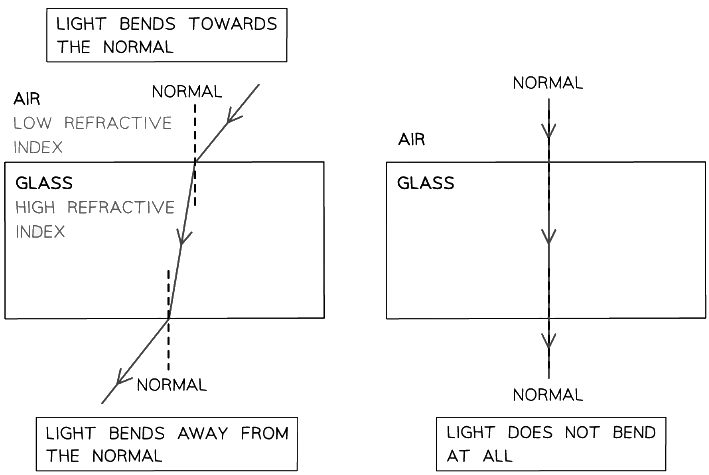 Refraction of light through a glass block
Refraction of light through a glass block
- The change in direction occurs due to the change in speed when travelling in different substances
- When light passes into a denser substance the rays will slow down, hence they bend towards the normal
- The only properties that change during refraction are speed and wavelength – the frequency of waves does not change
Calculating Refractive Index
The refractive index, n, is a property of a material which measures how much light slows down when passing through it

- Where:
- c = the speed of light in a vacuum (m s–1)
- v = the speed of light in a substance (m s–1)
- Light travels at different speeds within different substances depending on their refractive index
- A material with a high refractive index is called optically dense, such material causes light to travel slower
- Since the speed of light in a substance will always be less than the speed of light in a vacuum, the value of the n is always greater than 1
- In calculations, the refractive index of air can be taken to be approximately 1
- This is because light does not slow down significantly when travelling through air (as opposed to travelling through a vacuum)
Snell's Law
- Snell’s law relates the angle of incidence to the angle of refraction, it is given by:
n1 sin θ1 = n2 sin θ2 - Where:
- n1 = the refractive index of material 1
- n2 = the refractive index of material 2
- θ1 = the angle of incidence of the ray in material 1
- θ2 = the angle of refraction of the ray in material 2
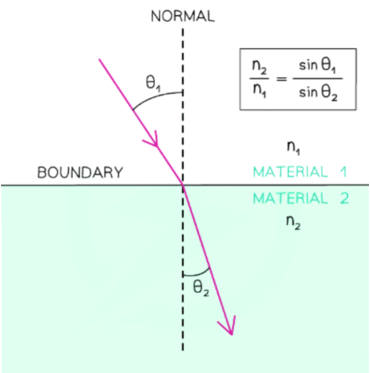 Snell's Law is used to find the refractive indices or the angles to the normal at a boundary
Snell's Law is used to find the refractive indices or the angles to the normal at a boundary
- θ1 and θ2 are always taken from the normal
- Material 1 is always the material in which the ray goes through first
- Material 2 is always the material in which the ray goes through second
Example: A light ray is directed at a vertical face of a glass cube. The angle of incidence at the vertical face is 39° and the angle of refraction is 25° as shown in the diagram.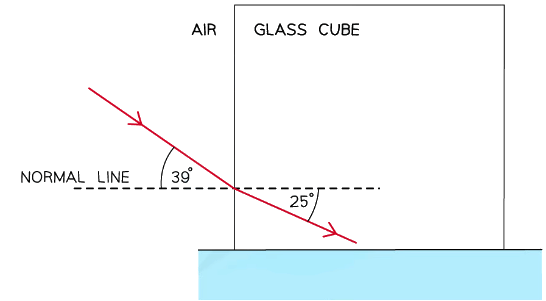 Show that the refractive index of the glass is about 1.5.
Show that the refractive index of the glass is about 1.5.
Step 1: Write down the known quantities
- Refractive index of air, n1 = 1
- Refractive index of glass = n2
- Angle of incidence, θ1 = 39°
- Angle of refraction, θ2 = 25°
Step 2: Write out Snell's Law
Step 3: Calculate the refractive index of glass
Note that in a "show that" question, the answer should be to at least one more significant figure than the value given in the question
Investigating Refraction & Total Internal Reflection
Aims of the Experiment
- The aim of the experiment is to calculate the refractive index of a transparent semi-circular block
Variables:
- Independent variable = Angle of incidence, θ1
- Dependent variable = Angle of refraction, θ2
- Control variables:
- Size of the semi-circular block
- Intensity of light
Equipment List

- Resolution of measuring equipment:
- Ruler = 1 mm
- Protractor = 1°
Method
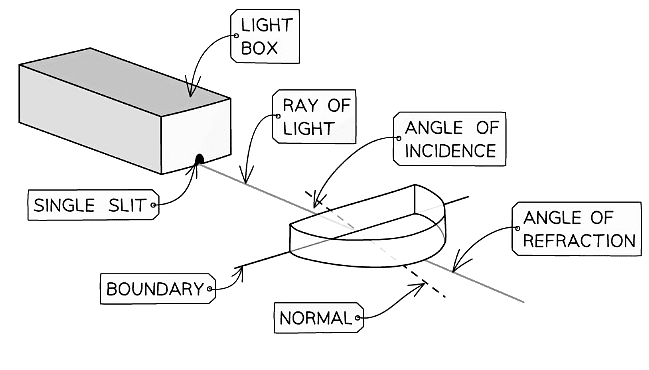 Apparatus set up to measure the effects of refraction through a semi-circular block
Apparatus set up to measure the effects of refraction through a semi-circular block
- Place the semi-circular block on top of the protractor with the centre of its diameter aligned with 0° on the protractor
- Direct the light from the lightbox towards this 0° and draw a dotted line perpendicular to the long edge of the semi-circular block. This is the normal
- Using the pencil and ruler, trace the ray entering the block and leaving
- Repeat this, moving the ray around every 10° up to 80. This is the angle of incidence, θ1
- The angle of the ray leaving the block from the normal is the angle of refraction, θ2. The block should preferably be removed to measure this accurately
- Record the angle at which the angle of refraction is 90°, (the ray leaves along the straight boundary of the block) just before it is reflected. This is the critical angle
- Repeat the experiment for the rectangular glass block
An example table of results would look like this:
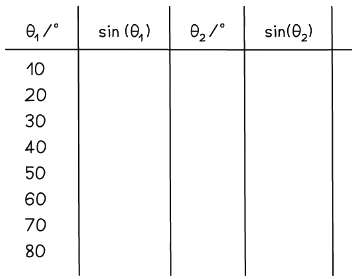 Example table of results
Example table of results
Analysis of Results
- The refractive index of the blocks is calculated using Snell's Law:
n1 sin θ1 = n2 sin θ2 - Since n1 is the refractive index of the first material, this is air and hence equal to 1
- Therefore, the refractive index of the blocks n is found using the equation:

- Therefore the gradient of the graph of sin θ2 against sin θ1 is the refractive index n
- The critical angle, C, can then be calculated using the equation

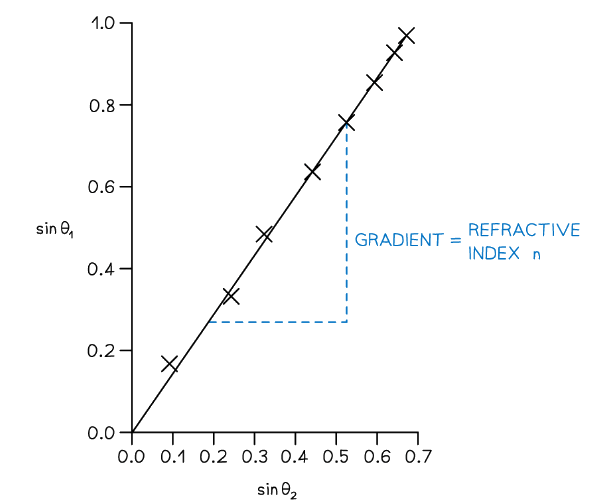 Example graph of results to measure the refractive index
Example graph of results to measure the refractive index
Evaluating the Experiment
Systematic Errors:
- The lines should be traced from the centre of the light rays each time
Random Errors:
- Use a pencil with a sharp tip to draw the lines on the paper accurately for each angle
- The light from the lightbox will be slightly blurry and dispersed, which gives a subjective reading for the angle
- Using a concentrate laser light will produce more defined rays so there is less uncertainty when tracing the lines
- Repeat the experiment and find an average reading of each angle of refraction
Safety Considerations
- Do not shine the light from the ray box in eyes as it can damage your eyes
- Lasers can permanently damage your eyesight therefore, wear laser safety goggles
- Don’t shine the laser at reflective surfaces
- Display a laser warning sign on the door
- Never shine the laser at a person
- Make sure the glass blocks are kept away from the edge of the surface of a table, as they could be damaged and crack if they fall
Total Internal Reflection
- As the angle of incidence is increased, the angle of refraction also increases until it gets closer to 90°
- When the angle of refraction is exactly 90° the light is refracted along the boundary
- At this point, the angle of incidence is known as the critical angle C
- This angle can be found using the formula:

- This can easily be derived from Snell’s law where:
- θ1 = C
- θ2 = 90°
- n1 = n
- n2 = 1 (air)
- Total internal reflection (TIR) occurs when:
The angle of incidence is greater than the critical angle and the incident refractive index n1 is greater than the refractive index of the material at the boundary n2 - Therefore, the two conditions for total internal reflection are:
- The angle of incidence, θ1 > the critical angle, C
- Refractive index n1 > refractive index n2 (air)

Example: A glass cube is held in contact with a liquid and a light ray is directed at a vertical face of the cube. The angle of incidence at the vertical face is 39° and the angle of refraction is 25° as shown in the diagram. The light ray is totally internally reflected at X.
Complete the diagram to show the path of the ray beyond X to the air and calculate the critical angle for the glass-liquid boundary.
Step 1: Draw the reflected angle at the glass-liquid boundary
- When a light ray is reflected, the angle of incidence = angle of reflection
- Therefore, the angle of incidence (and reflection) is 90° – 25° = 65°
Step 2: Draw the refracted angle at the glass-air boundary
- At the glass-air boundary, the light ray refracts away from the normal
- Due to the reflection, the light rays are symmetrical to the other side
Step 3: Calculate the critical angle
- The question states the ray is “totally internally reflected for the first time” meaning that this is the lowest angle at which TIR occurs
- Therefore, 65° is the critical angle
Wave Phenomena
Reflection, Refraction, Polarisation & Diffraction
Wave phenomena are unique to waves and not particles. These include:
- Reflection
- Refraction
- Polarisation
- Diffraction
Reflection
- Waves reflect from all surfaces, this is seen in mirrors

The key feature of reflection is the angle of incidence i is equal to the angle of reflection r
Refraction
- Refraction is when light travels at a different speed when travelling through another medium
- This is seen when light passes through a boundary such as from air to glass
- White light splits into a spectrum due to refraction
- violet light is slowed down more and refracts more than red light
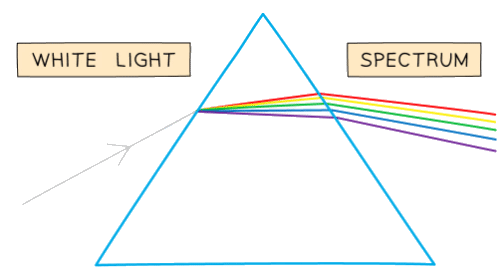 Refraction of light through a prism
Refraction of light through a prism
Polarisation
- Polarisation is a wave phenomenon that only occurs for transverse waves
This is when the vibrations of transverse waves are restricted in one direction
 Polaroid sunglasses use polarisers to reduce glare
Polaroid sunglasses use polarisers to reduce glare
Diffraction
- Diffraction is the spreading out of waves when they pass an obstruction
- This obstruction is typically a narrow slit known as an aperture
- It usually represented by a wavefront
- The only property of a wave that changes when it diffracts is its amplitude
- This is because some energy is dissipated when a wave is diffracted through a gap
- The effects of diffraction are most prominent when the gap size is approximately the same or smaller than the wavelength of the wave
- As the gap size increases, the effect gradually gets less pronounced until, in the case that the gap is much larger than the wavelength, the waves are no longer spread out
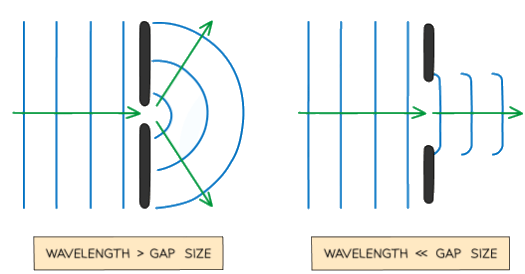 The size of the gap (compared to the wavelength) affects how much the waves spread out when diffracted
The size of the gap (compared to the wavelength) affects how much the waves spread out when diffracted
- The diffraction pattern of light can be represented as a series of light and dark fringes which show the areas of maximum and minimum intensity
- If a laser emitting blue light is directed at a single slit, where the slit width is larger than the wavelength of the light, it will spread out as follows:
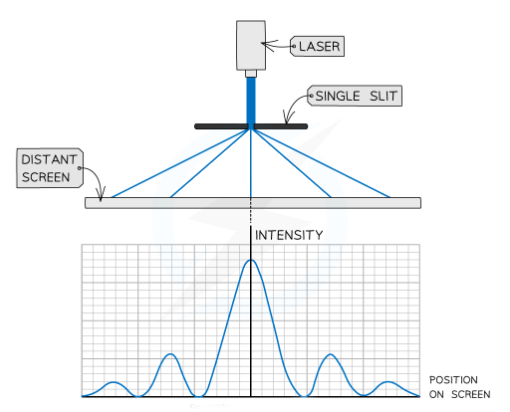 The intensity pattern of blue laser light diffracted through a single slit
The intensity pattern of blue laser light diffracted through a single slit
If the laser were to be replaced by a non-laser source emitting white light:
- The central maximum would be white
- All maxima would be composed of a spectrum
- The shortest wavelength (violet / blue) would appear nearest to the central maximum
- The longest wavelength (red) would appear furthest from the central maximum
- The fringe spacing would be smaller and the maxima would be wider
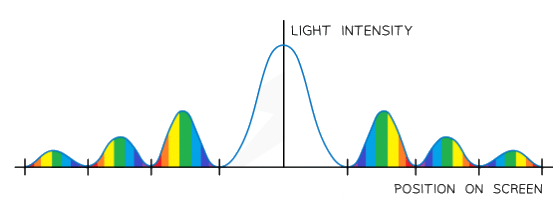 Qualitative treatment of the variation of the width of the central diffraction maximum with wavelength and slit width
Qualitative treatment of the variation of the width of the central diffraction maximum with wavelength and slit width
|
142 videos|312 docs|132 tests
|


















